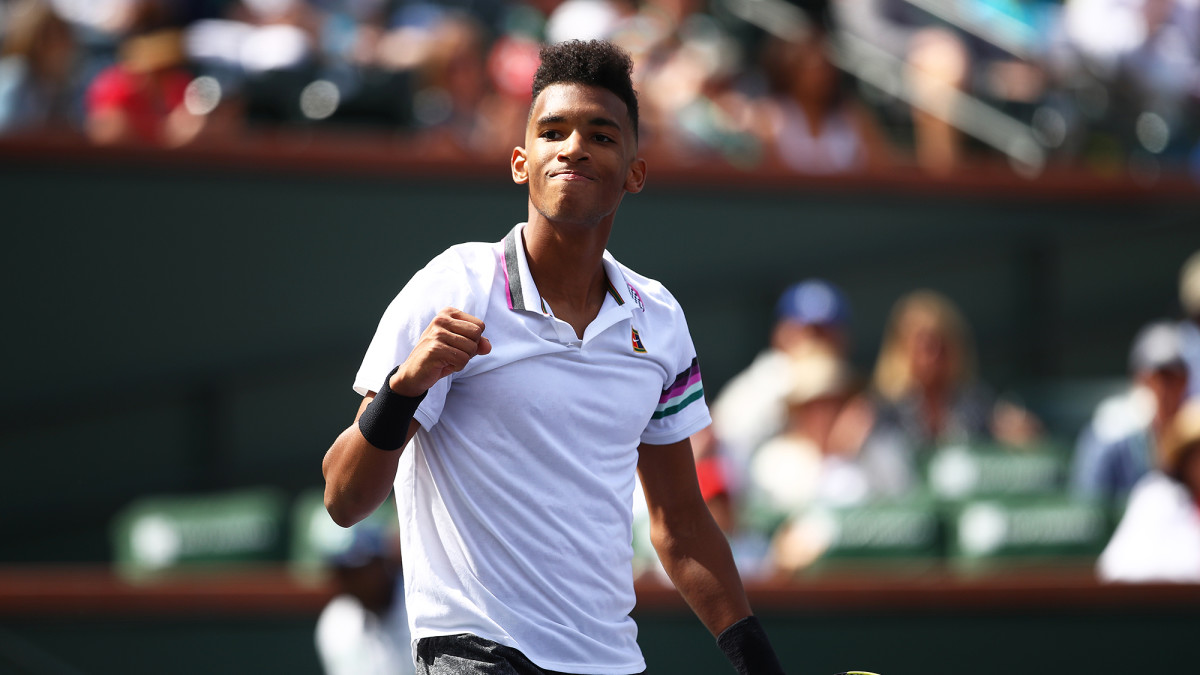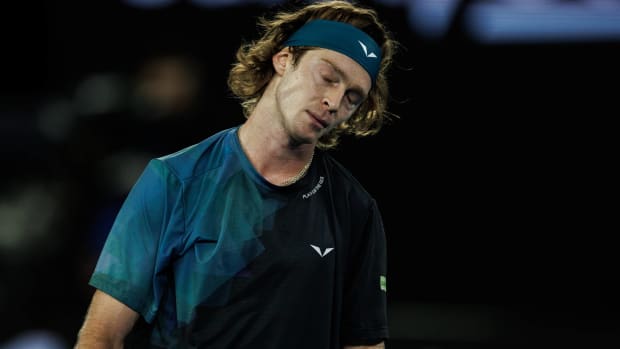Mailbag: Checking in From Indian Wells
INDIAN WELLS, Calif. — Hey, everyone…
Here’s a mid-tournament podcast from Indian Wells, in which Jamie Lisanti and I discuss what’s been a compelling tournament thus far.
And here’s a mid-tournament “Mailbag” from the 2019 BNP Paribas Open.
Instead of our normal Q&A format, here come a dozen or so items. I tried to incorporate as many of your questions as possible…
Without further ado…
MAILBAG
Have a question or comment for Jon? Email him at jon_wertheim@yahoo.com or tweet him @Jon_Wertheim.
• So often the recent tennis conversation has centered on age-defying feats. Federer and Serena at 37! Venus at 38! Thirty is the new 20! The Bryans still rolling at 40! Even steady Philipp Kohlscreiber, 35, is now eligible for senior tennis…but wait, he’d rather be taking down Novak Djokovic.
Thanks largely to the Canadians—but also Amanda Anisimova, Stefanos Tsitisipas and, soon, Coco Gauff—the age-defiance is starting to go in the other direction as well.
Felix Auger-Aliassime, age 18, leaves here on the cusp of the top 50, and he simply took the racquet out of Tsitsipas’ hands in round two. He is defending few points this year—he has never before played the French Open or Wimbledon—and could easily be seeded by the U.S. Open. There is so much to like here but, above all, he is such a composed and pleasant kid. After losing to Yoshi Nishioka 7-6 in the third in a match that, frankly, Felix should have won, he shook Nishioka’s hand and thanked him for a great match. If this is a central component of the post-Big 3 future, we’re going to be okay here, friends.
• As long as we’re on the subject of 18-year-old Canadians, Bianca Andreescu is (at time of publication) still in the draw and still clobbering tennis balls. As a player, she reminds me a bit of Coco Vandeweghe: a slugger who can exchange tracer fire with anyone. Like her compatriot FAA, she is defending very little and could easily be seeded by the summer Slams.
• What? We’re still on the subject of teenage Canadians? Denis Shapovalov, a wizened 19-year-old, easily handled Marin Cilic on Tuesday. Man, are they doing something right up there.
He also broke into a rap after the big victory…
I’ll say this: Shapo is doing his part to explode the myth that tennis is an uptight country club sport.
• That sound you heard? That’s the Uniqlo money truck backing up to entice Naomi Osaka in advance of Tokyo 2020. Which is to say: Don’t, perhaps, get used to her in Adidas much longer.
• Two years ago, Yoshi Nishioka—best known for hitting one of the great shots in tennis history—https://www.youtube.com/watch?v=EkEZBsLwUq0
was going gangbusters. He was 21 and rising the ranks, despite standing 5’7”. Then, in a Miami match against Jack Sock, he blew out his knee. Two years later, he’s back. Between him, Osaka and Nishikori, these be good times for Japanese tennis.
• Want to know why Venus Williams is still playing tennis? Because she feasts on competition and can still knock off players like Petra Kvitova. And under the right circumstances, she can win four straight matches and find herself deep in big-time events…like she has here. She’ll face Angelique Kerber in the quarters on Thursday.
• Breakthrough of the tournament: Marcos Giron, the 2014 NCAA singles champ from UCLA who got some mouthfuls of sand in the challenger desert…but found an oasis in Indian Wells. (And with that, we retire a horrible metaphor.) Giron won’t beat you with power, but he is rock-solid off the ground. He was up 4-1 in the third against Milos Raonic, and while some bitterness over his failure to close will linger, he’s really to be commended. His tennis is strong and his personality is stronger.
• Fresh off his running the mesa in Acapulco, Nick Kyrgios came in with all sorts of heat, as they say in Hollywood. The salon eagerly awaited his third-rounder against Djokovic. And then Kyrios wilted against Kohlschreiber. The concern about Alexander Zverev: he’s gangbusters day-in, day-out but wilts in the big events and big matches. The concern about Kyrgios: he’s gangbusters against the big guns, but plays listlessly against journeyman during a sleepy afternoon session.
• We encourage you guys to go easy on the Kyrgios comparisons. She, after all, is a Grand Slam champ, embedded—at least for the rest of the month—in the top five. But, yes, we have to talk about Sloane. With a chance at becoming No. 1 at this event, Stephens lost in her first match to Stephanie Voegele, a Swiss qualifier. (And Stephens is now 1-5 against Voegele.) Such are the trendlines for Stephens. There will be nodes and crests. Sure, you wish she were steadier. But she is comfortable with the high-highs and low-lows, and that’s a critical point.
•Even given the limbo-bar standards, tennis politics are uncommonly toxic and self-defeating these days. On the eve of the tournament, ATP CEO Chris Kermode, seeking a contract extension, was essentially voted out when he did not receive the requisite votes from the players’ side of the ATP board.
As the de facto leader of the players’ council—which expresses its will to the player reps on the board—Novak Djokovic is to be commended for willingly taking a political role and for using the authority that comes with being the world’s top player. But when you have orchestrated this palace coup and a leader is then deposed, you undercut your authority when you fail to own it. Djokovic’s cagey reluctance to explain—let alone defend—his position, was not exactly a good look. He did the same thing last year in Australia. Want to consider unionizing? Great! It makes a lot of sense. (Symphony orchestras around the world have shown that independent contractors can, in fact, unionize.) But when you bring up unionization at a meeting, your fellow players talk about it, and then you retreat, you lose authority.
And when Federer and Nadal take issue with your communication and your backroom maneuvering, you are really in some trouble. Here’s Federer the other day:
https://www.youtube.com/watch?v=IKATOyowQZ8
Look, maybe Djokovic and Justin Gimelstob—leader of the player reps on the board and another voice of opposition against Kermode— have a plan. Maybe they will emerge as heroes. Maybe the current structure doesn’t work. But the onus has now shifted to them.
• Here’s my overarching take: a board—and the constituents it represents—are entitled to make changes they feel will benefit the enterprise. In fact, they have a duty to do just that. But I fear this has echoes of Brexit. “The status quo sucks! Let’s blow this up! What’s our plan? Aw, we’ll deal with the details later.” Right now, the burden is on Djokovic and the player board to either A. find a leader who improves the ATP balance sheets or B. offer a coherent path to unionization or alternative structure. But to defenestrate a leader without an articulated alternative is concerning.
• Let me make this point about Kermode: While serving as ATP CEO is an impossible job—which, in itself, supports Djokovic’s contention that the entire system needs an overhaul—Kermode acquitted himself honorably. Opinions varied on how well he performed his duties. But he left with his reputation and dignity intact.
• Long as we’re on politics….the disastrous ITF World Tour continues to be a source of discussion and heated objection here. Magnus Norman and Toni Nadal are among the latest to join 15,000 petition signers in expressing their dismay. Any change is going to cause pain and trigger dissent; but even by tennis standards, the blowback has overwhelming and been overwhelmingly negative. Some topline points:
1. Sounds basic, but the ITF hasn’t even clearly answered the most fundamental question: Why did you do this? Some executives say this streamlined tour was conceived to improve the economics in pro tennis and basically eliminate the thousands of players who are technically pros have no chance of making a living. Other executives say it’s a direct response to corruption and match-fixing at the lower levels. Which is it?
2. Conducted at a price of $25 million, the independent Report clearly states: “In the Panel’s assessment there is a strong causal connection between the sale of official live scoring data to the Lowest Level and the growth in betting on matches at that level.” So long as that’s the case, and the ITF ignores this—unwilling to end or even amend its data deal—it has surrendered all high ground.
3. The “every sport has a data deal” response misses the point. The NBA has a data deal for selling NBA data and live NBA scores. It doesn’t make money from low-level pro basketball games in far-flung locations, where athletes have economic incentive to cheat. If the ITF wants do a data deal for Slams and tour-level events, fine. It’s the lower level data that is triggering the majority of the corruption.
4. Distilled, the USTA’s response is essentially: “We agree this tour is horrible, but it was foisted on us.” But that doesn’t wash. You are the most powerful national tennis federation in the world. You have an event that makes $400 million or so in gross revenues. You have a designated seat on the ITF Board. The Independent Report is clearly not a sacred document when the most fundamental point—to end live scoring at these small events—is being ignored. American tennis and college tennis is absorbing so much damage here. The idea that the USTA was—and is—powerless to stop all these opportunities from evaporating? That beggars disbelief. Inasmuch as “promote and develop the growth of tennis” remains the USTA’s mission, this central guiding principle was deeply neglected here. Someone needs to be held accountable for this.
5. An intrepid journalist with more bandwidth than I can devote should venture down this rabbit hole. This has the distinct whiff of something rotten, of something more sinister than mere incompetence.
• On a happier note, I’m doubling down on the point I made in Australia. Old-to-young, top-to-bottom, men, women, Americans, Europeans...collectively, today’s players comprise a really awesome work culture. In Dunder Mifflin terms, The Jims and Pams outnumber the Dwight Schrutes 50:1.
Last Sunday at the Tennis Channel desk, we had Gael Monfils, Felix, the Bryans, Danielle Collins and Federer come through within a few hours of each other. Think about the diversity here. Four decades, four countries, two genders, one artificial hip. Each was more pleasant than the next. As long as tennis attracts this caliber of people and athlete, the empty suits and the careerists and the opportunists and the narcissists and hypocrites can fight all they want. The sport will still be in a good place…





